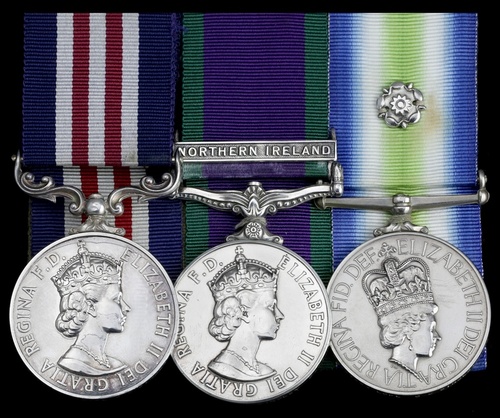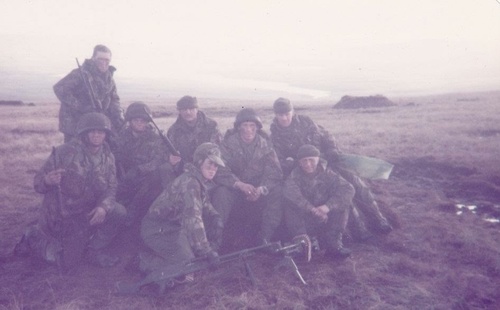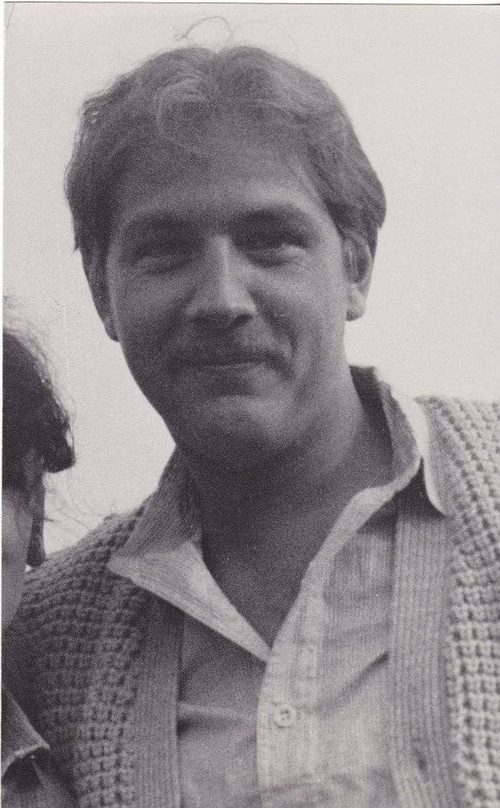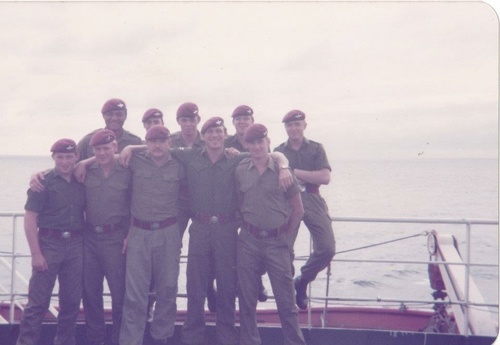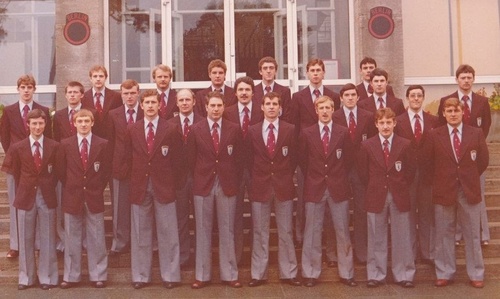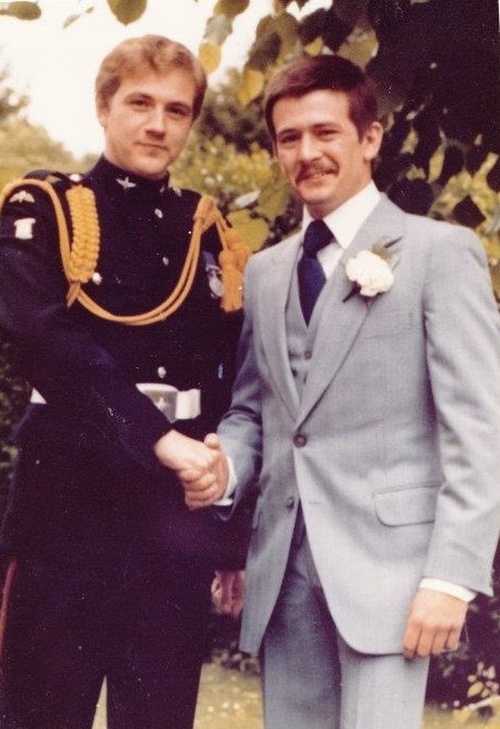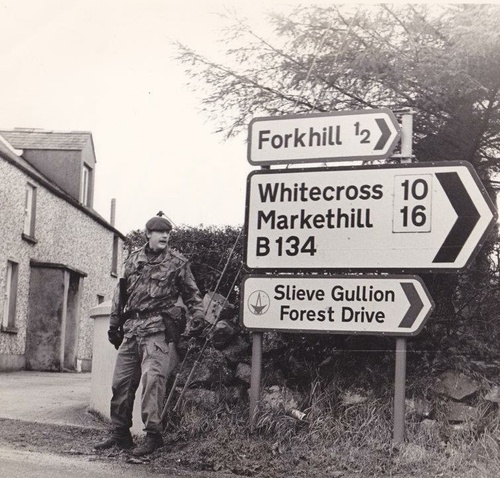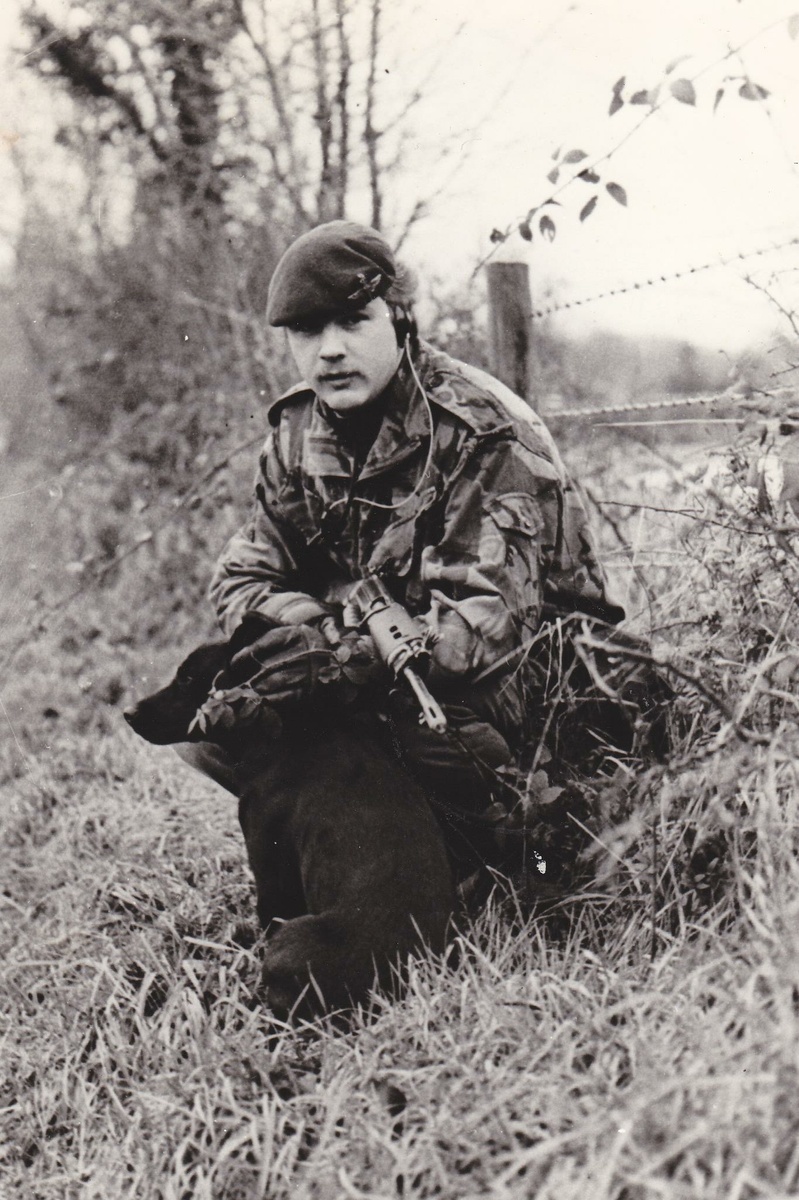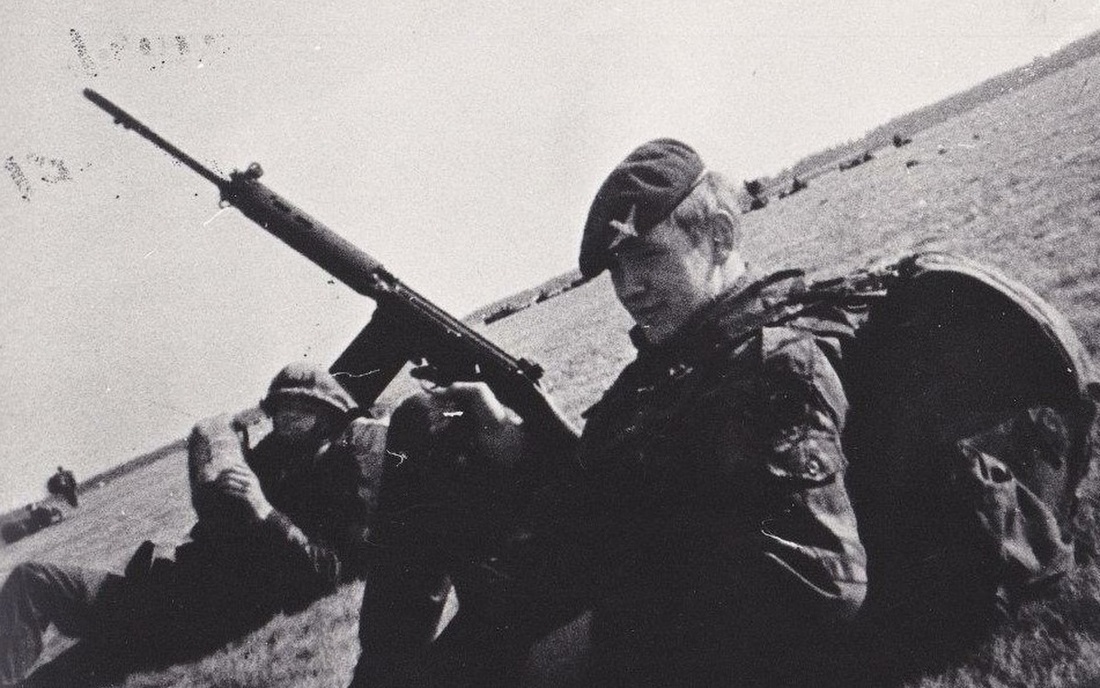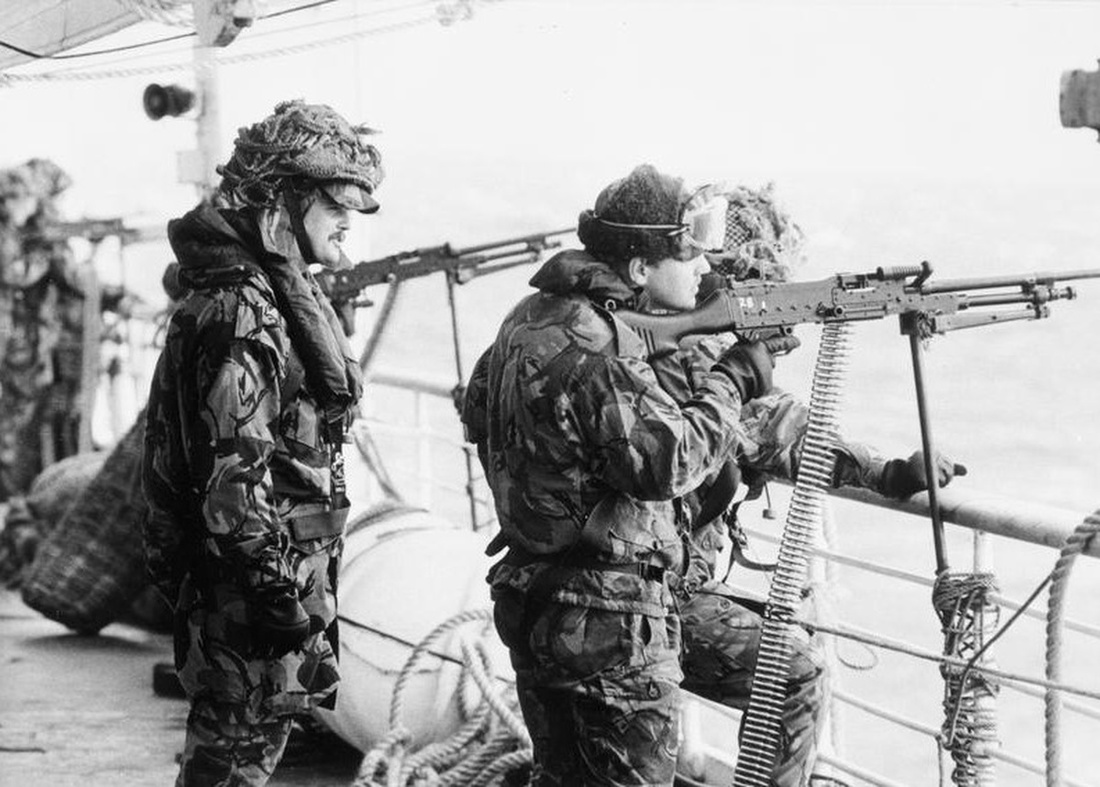Auction: 18001 - Orders, Decorations and Medals
Lot: 595
INTRODUCTION
'The Paras - Britain's elite airborne infantry; the Parachute Regiment leads from the front.'
The Ministry of Defence's website, refers:
https://www.army.mod.uk/who-we-are/corps-regiments-and-units/infantry/parachute-regiment/
It was Winston Churchill - 'The Greatest Briton of All Time'- who set in motion the foundation of what became known as the Parachute Regiment. During the Blitzkrieg in 1940, he saw the havoc which could be created by a corps of paratroopers, able to operate independently and aggressively in all manner of terrain.
Following the success of the first Churchill-inspired parachute-led mission - Operation "Colossus" - the Parachute Battalion would gain its first great success during Operation "Biting", the Bruneval Raid. Their indomitable C.O. - Major J. D. 'Johnny' Frost (later Major-General, C.B., D.S.O. and Bar, M.C.) would embody everything this 'band of brothers' represented: unrelenting warriors of the most determined kind.
That determination in the face of great odds became a hallmark of the 'Red Devils', not least on the battlefields of North-West Europe 1944-45. Arnhem needs no introduction here, but its inspiring story of heroism and stoicism today lives on in the ranks of the Parachute Regiment.
Evidence of that fact is to be found in the words of Lieutenant-Colonel Christopher Keeble, D.S.O., who assumed command of 2 Para following the death of Colonel 'H' Jones in the battle for Goose Green:
'I was enormously attracted to the Parachute Regiment because of this wonderful feeling of comradeship. We all have to go through a traumatic selection process, which weeds out a great number of people. We are united in our hardship, by what we have done. It is a very good way of preparing for the actual trauma of war. Soldiers do not fight for Queen and country, or even for Maggie - they fight for each other. But they need to know that their comrades would do the same. Selection produces that mutual trust.
I remember parachuting onto the Arnhem drop zone with our sister battalion, 10 Para, on their annual pilgrimage to the battlefields and the war cemetery. After the jump, we visited the Oosterbeck crossroads, the scene of fierce fighting on the outskirts of Arhnem, and we listened to one of the very few survivors of that battalion describing the battle for the Crossroads.
Someone in the audience said to the speaker,
"What made you go on fighting when the battalion had been largely destroyed, the cause lost and the defeat inevitable?"
He paused, looked across the suburban junction and with tears brimming up in his eyes he said quietly and simply,
"They were my friends."
That's how it is in 2 Para. We had spent our practice-training fusing the individuals together. The fire of war merely tempered that process. We would never have given up. We would have fought to the last man rather than not achieve the mission.'
No wonder the Parachute Regiment has been actively deployed for every year of its existence, bar one. No wonder its ranks have won a multitude of decorations, from two V.C.s at Arnhem through to Corporal 'Josh' Leakey's more recent award for Afghanistan. It is a combat record that is second to none.
No better example of that fighting spirit can be quoted than 2 Para's epic encounter amidst the tunnock-strewn terrain of Darwin Ridge and Goose Green in the early hours of 28 May 1982. That vital battle - and the heroic example set by the likes of Lance-Corporal G. D. 'Gaz' Bingley - made possible the final liberation of the Falklands.
One of his comrades puts it best:
'Gaz set the tone for how we fought our war. His bravery and determination showed us the way forward and showed the Argies what they were up against. A true airborne warrior.'
In Goose Green; A Battle is Fought to be Won, Mark Adkin neatly summarises the significance of 2 Para's victory:
'Nothing succeeds like success, or depresses like failure. For Britain a win at Goose Green was even more essential than the Argentines. Consider for a moment the consequences of a 2 Para defeat coming on top of a week in which the Royal Navy had been hammered by the Argentine Air Force, losing four ships and having five badly damaged.
Apart from the inevitable slump in the Task Force's morale and the dismay at home, it would seem to the world that Britain's launching of Operation Corporate was a ghastly and expensive mistake.'
Sold by Order of the Recipient's Widow
'Gaz was the first of our dead to be recovered. The story of the last few minutes of his life had already reached us through Baz Grayling. They had been making a frontal charge on an Argie machine-gun post. Grayling was hit at close range in his water bottle; it exploded shattering his hip. As Grayling collapsed, still firing, they silenced the Argie M.G.
But as fate would have it the last few rounds squeezed off by the Argie gunner ripped through Gaz Bingley's head, killing him instantly.'
Lance-Corporal Bentley, 2 Para's Medic, in Goose Green; A Battle is Fought to be Won.
The important - and unique - posthumous 'Battle of Goose Green' M.M. group of three awarded to Lance-Corporal G. D. 'Gaz' Bingley, 11 Platoon, 'D' Company, 2nd Battalion, The Parachute Regiment
A popular member of his Battalion and a gifted Combined Forces' footballer who had seen service in Northern Ireland, Bingley displayed all the attributes of a 'true born airborne warrior' in the early hours of 28 May 1982
On parting with his wife for the last time, he told her "I've waited six years for this." His long-served C.O. - Lieutenant-Colonel Herbert 'H' Jones - had waited even longer and was incandescent with rage when ordered to cancel his first advance and return to the bleak surroundings of Sussex Mountain: "I've waited twenty years for this and now some f------g marine's cancelled it!"
But the waiting ended for them both in the coming battle for Goose Green. Pinned down and under pressure to make progress, Bingley led his Platoon in an assault on staunchly-defended trench systems and personally attacked an enemy machine-gun bunker face-on: that assault - in an action near identical to that of the posthumous V.C.-winning exploits of his Colonel later that morning - cost him his life
By way of example, concluded his Company C.O., 'It was that sort of immediate get up and go and flair that really got us out of a very sticky situation.'
Military Medal, E.II.R. (24347663 L Cpl G D Bingley Para); General Service 1962-2007, 1 clasp, Northern Ireland (24347663 L Cpl G D Bingley Para); South Atlantic 1982, with rosette (24347663 L Cpl G D Bingley Para), the last two mounted court-style as worn by his widow, together with his M.M. riband, edge bruising, otherwise nearly extremely fine (3)
M.M. London Gazette 8 October 1982:
'Throughout 28 May 1982, the 2nd Battalion, The Parachute Regiment, were engaged in fierce fighting to take well entrenched enemy positions in the area of the Goose Green settlement on the Island of East Falkland. Lance-Corporal Bingley was a Section Commander.
During the battle his section came under fire at close quarters from two enemy machine-gun posts. To destroy the enemy positions he led his section in the assault and whilst leading was fatally wounded.
His heroic action enabled his company to continue their advance and was significantly instrumental in defeating the enemy.'
The original recommendation, submitted by Lieutenant-General Sir R. Trent, was accompanied by the following remarks of the Forwarding Authority, Admiral J. D. E. Fieldhouse, Royal Navy:
'Lance-Corporal Bingley displayed outstanding heroism and leadership in the face of the enemy and is recommended for the posthumous award of the Military Medal.'
Gary David 'Gaz' Bingley was born at Muswell Hill, London on 28 February 1958, the eldest of five children. A lifelong supporter of Tottenham Hotspur, he throughout his career stated he was born in Tottenham, an inaccuracy that even appeared on his Death Certificate.
Despite being gifted with a quick intellect - and good humour - Bingley passed through school without much success apart from on the football field. Forgoing further education, he enlisted in the Infantry Junior Leader's Battalion at Shorncliffe, Kent, passing out of Inkermann 'P' Company in October 1975.
Having gained his Parachute Regiment 'Wings', he completed a tour of Northern Ireland in 1977. It was during a period of rest and recuperation that he met his wife, Jay, on 28 February 1977, on his 19th birthday. Despite having only known each other for four months, during which they spent three weeks together, his character shone through. Leaving for a 24-month tour of Berlin later that Spring, his first letter home contained his proposal. They were married in Taunton on 9 July 1977, with a daughter born the following year. During his time in Germany, Bingley's football prowess shone through. He would soon rise to represent the Battalion and the Combined Services XI selected for the Berlin Tattoo.
Tour-expired, he returned to Northern Ireland for another tour, this time based at Ballykinler. He was lucky to escape the Warrenpoint ambush in August 1979, which would prove to be the costliest I.R.A. attack on British troops for the entirety of 'The Troubles'. Jay remembers being at home when the news came through on the telephone of an attack, her husband remaining at barracks as result of having been 'out on a job' the previous day.
'I've waited six years for this'
Having returned to Aldershot in 1981, Bingley served in 'A', 'B' and 'D' Companies and was a well-known and popular member of the Battalion. With news of the unfolding events in the South Atlantic and the cancellation of a proposed tour of Belize, 2 Para stepped up for the chance of a large-scale conflict, something most of the members of the Battalion had craved since enlisting.
Lieutenant-Colonel Herbert 'H' Jones was on holiday in France when the news of the impending deployment broke. He rushed back to England before sailing straight for Ascension Island, with Major C. Keeble, his 2nd in Command, being given a week for intensive training before the Battalion was embarked.
His kit packed, the famous last words from Bingley to his wife whilst boarding the M.V. Norland for the journey south on 26 April 1982 are quoted above.
He was Platoon Leader, 11 Platoon, 'D' Company, under the command of Major P. Neame.
Operation "Corporate"
With a 21-day voyage ahead, training and preparations for the war were done afloat.
Neame takes up the story:
'I got my Company to prepare in the finest detail so that everyone was minutely ready for every eventuality. I think the biggest loss of confidence occurs when you get caught on the hop. The object therefore was to try to reach the stage where at least we had the reassurance that we'd talked through every situation, which could only help morale.
I couldn't very well tell them what it was like because I didn't know myself. All I could was to try and anticipate the difficult areas beyond the military textbook and to try and get across to platoon commanders and, through them, the whole way down, what I was expecting of them and what I was likely to do in certain situations. Then at least my behavior and actions would be predictable and expected and we'd all be working along the same lines.
I was also concerned about how much kit we should take ashore. I spent days trying to pare it down to essentials. H. even decreed that to reduce weight we wouldn't take bayonets as we were going to win the battle with firepower. I thought, "That's all right until things go wrong."
So I managed to persuade him that we should take them as tin openers. He didn't normally brook arguments but that rather appealed to him.
The other thing I found myself lumbered with was Sports Day. I must admit it was quite a good day really. We were a bit limited for space but I set up a tug-of-war which got everybody on the top deck cheering anyway.
As we went further south I had to organize a second Sports Day and by then the weather was getting rather rougher and H. took one look at the steeplechase and the slippery decks and the force 5 winds and decided that we were more likely to lose more men on a repeat performance of that than going up against the Argentineans!'
Landed on Blue Beach at Ajax Bay on 21 May, 2 Para initially took up positions on Sussex Mountain.
'It's on - it's off - it's on again'
Laden down with exceptionally heavy burgens, the march up to positions on Sussex Mountain was a treacherous one. Avoiding broken ankles amongst the draining tunnock and the constant threat of air attack, the conditions were far colder and more exposed than down at the shoreline. Shots were fired at the aircraft bombarding the British ships as they passed overhead.
'D' Company were charged with pressing forward to take Camilla Creek House on the afternoon of 24 May - having set off on an 11-mile tab, they were ordered to about turn and return to the trenches on the Mountain as no air support could be gathered due to the conditions. 'H'. wasn't best pleased:
'I've waited twenty years for this and now some f------g marine's cancelled it.'
After six days in truly appalling conditions on Sussex Mountain, 27 men had been evacuated, 12 of those as a result of trench foot. Finally, by the evening of 26 May, all of the 450 standing soldiers of 2 Para would push down to take the House - led out again by 'D' Company, who sidled packs and advanced in simple fighting order, but weighted down with an incredible amount of ammunition and rations, ready to fight to the last if required.
The Company swore and stumbled its way through the black night, across unseen streams, bogs and the rock-strewn landscape. By 3 a.m. it put up the signal confirming the objective had been taken, with the trails of the Battalion following suit. Soaked and frozen, they settled down for three hours sleep.
Requests for light tanks were made, but petrol was short and the request was rebuffed. The same happened with requests for tracked vehicles to move the Battalion's heavy guns. As a result, just two of the Battalion's eight mortar tubes made it to Camilla Creek.
When light broke on 27 May, the position was clearly vulnerable for all too see. Visibility beyond 500 yards was impossible and they were open to attack from all sides. Nonetheless, it was decided to take shelter together during the day, in preparation for their battle that night.
'H' would soon be incandescent with rage once again. Lance-Corporal 'Bill' Bentley, summed things up:
'We got word some pillock back in England had warned the Argies we were coming.'
It had been announced on the B.B.C. World Service that 2 Para were within five miles of Darwin. The men were ordered to spread out and prepare for the Argentine attacks, by land, sea or air which were considered to be imminent. Famously, 'H' penned a letter to the Secretary of State for Defence that he should sue if any of his men were killed as a result. It is well-known the Argentine forces used helicopters to reinforce the very areas 2 Para were destined to attack.
It was soon after noon that a TAC Team of 'C' Company engaged and captured a Land Rover with three Argentinean troops, two of them wounded. The Officer was good enough to reveal the Darwin Garrison was on high alert and ready for an attack.
Later that afternoon, the Officers of 2 Para met to decide the plans for the attack. Neame summed it up well:
'After the B.B.C's message we were dispersed all around the house with nothing to do except think about tomorrow. I had a long look at my map. What I saw was not particularly reassuring. A long narrow isthmus with little chance to manoeuvre, and the Argies knew we were coming. A frontal attack against an alerted enemy.'
It was known that the Argentine defences comprised at least three rifle companies, in addition to some Air Force personnel, but the exact number of reinforcements was unknown. Mixed intelligence from previous patrols in the area did little to clarify the situation. It was however known that a system of at least 16 trenches near Darwin Hill, with more near Boca House and Darwin itself, had been seen.
What resulted was a six-phase, night-day - and hellishly noisy - attack to cover the distance. No doubt whilst huddled around the map visions of Arnhem were running through the minds of all concerned: the ground favoured the defenders, as did the numerical comparisons; but nothing was to stop the 'Red Machine'.
Goose Green
According to their plan, what faced 2 Para was simple on paper - approximately 14km. of terrain to be covered, dominated and captured in 14 hours: what followed was the most important action of the entire war.
Having crossed the start line in the small hours of 28 May, the first contact was met by Corporal Margerison, a section commander in 6 Platoon, 'B' Company. He recalled that contact in May 1983:
'About three minutes after starting our advance we came across an Argy, our first test! There was no face just a helmet and a poncho. I challenged him and told him to put his hands up, but he just said: "Por Favor". On the third time his hands moved under his poncho and in unison two riflemen and my two GPMG's opened fire. Not unnaturally he fell over.'
Following in reserve, 'D' Company - with Bingley at the head of 11 Platoon - was initially held up. Moving through the night, the firefights had grown into a crescendo as day broke. 2 Para was met by a dug-in, prepared and motivated enemy but had completed the first half of the objectives successfully.
It would be upon Darwin Ridge after daybreak that 'D' Company would come to the fore. As often occurs in the heat of battle, the original plan for Neame's men had to be adapted. They had followed 'C' Company as directed to their start line. However, in the darkness and with '… this enormous gaggle of bodies' it soon became clear they had overshot the mark, finding themselves not only in front of the RV, but ahead of Colonel Jones.
Neame takes up the story:
'The last thing I wanted was to end up ahead of 'A' and 'B' Companies and get caught up in their crossfire. So we trod a very careful path back to a known start point, found the track and sat down to wait for our battle to start.
Fortunately 'A' and 'B' Companies were still ahead of us, but what I hadn't taken into account was that we had got ahead of H.'s Tactical H.Q. He came stomping down the track, found us there and took this as a most immense personal affront that his reserve company was actually closer to the battle than he was. Suitably chastened we just sat where we were and watched him go stomping further down the track only to find himself caught in crossfire further down. By this time both 'A' and 'B' Companies had put in an attack of sorts. H. came stomping back and having been shot at, identified one position where he thought the fire came from and directed me to go and destroy it. My only difficulty was that I couldn't really see where this position was and he didn't really know where it was on the map. So we called up a fire mission from the ship that was offshore, hoping it was one of the pre-targeted objectives. They gave us about two rounds and then the gun jammed on the ship, so that was a great start! We were already underway so it just became an advance to contact and hope for the best.'
This was the decision which threw 'D' Company into the heat of the battle, instead of during Phase 3. They would find themselves in the face of the trench system under the command of Lieutenant Manresa's Company.
Darwin Ridge - frontal charge - posthumous M.M.
What followed is best described by those present. First Neame, honest as ever:
'By then we were ahead of the other two companies. We dimly saw a position on the skyline ahead of us which offered no opposition at all. So we just went straight into a frontal assault which was the first time I'd been in action in my life. It all seemed to be going well, when suddenly two machine-guns opened up on us from the right. Up until then I had thought, if this is war, it's all dead easy.
But now we were suddenly really caught flat-footed. There was already one platoon clearing the position in front of us, the platoon on my right was completely pinned down by two machine-guns and the difficulty was getting any troops available to maneuver around and actually assault this position.'
Lieutenant Shaun Webster, in command of 10 Platoon, adds further detail:
'There was suddenly a huge racket and tracer started flying everywhere. We took cover and returned fire. I can remember thinking how strange that they should let us get so close because we must have been 30-40 metres away. Their tracer was green and white and ours red, the colours were amazing.
Corporal Staddon's section and platoon H.Q. were best placed to move closer towards the enemy so we crawled in more or less a straight line towards them. Suddenly a heavy caliber opened up and I think that was when Lance-Corporal Cork was hit in the stomach. Private Fletcher went to assist him and at about that time some mortars started falling on us. Luckily the ground was soft and absorbed most of the blast, but I remember thinking that command and control is all very well but what can you do when you and everyone around you is deaf!
As we lay there an Argie got out from his cover and started to walk very slowly and deliberately away from us, he didn't have a weapon and I think he must have been shell-shocked as their mortars fell amongst their position as well. We continued moving towards their position until we could throw grenades. A few WP and L2's were thrown and ended it. We did not know what had become of Cork or Fletcher. I sent Corporal Staddon to look for them but he could not find them. The Company had to move on so we informed the C.S.M.'
Neame continues:
'My other force available was my third platoon and any direction they were likely to attack from would mean assaulting straight in towards the direction I thought 'B' Company was. After a certain amount of flat-footedness, sucking of teeth and wondering what the hell to do, I saw that Chris Waddington [11 Platoon] had already started bringing his platoon across so that they could assault. I was still concerned that they'd be shooting up 'B' Company in the process, but there was no option.
By this time H. was yelling to find out what the hell was holding us up. So I told Chris to go in and assault and in he went. I got a few expletives from John Crossland about the number of rounds that were coming his way and I answered with expletives about the number of rounds that were coming my way and we just got on with it.
This assault led to four casualties.
One of those killed was Corporal Bingley who was very brave.
He'd gone to ground not really knowing quite where these machine-guns were and found himself virtually overlooking the position. He and Grayling just went in and did an immediate assault and the two of them took the five-strong position between them.
But Bingley was killed in the process and Grayling slightly injured. It was that sort of immediate get up and go and flair that really got us out of a very sticky situation.'
The story of Bingley's gallantry is elaborated on by Lance-Corporal M. W. L. 'Bill' Bentley, M.M., whose medals were sold in these rooms in July 2007. It was Bentley who brought in Bingley's body:
'As daylight approached, we started to search for those of 'D' Coy still missing. Padre Cooper called me over, he had found Gaz Bingley. Gaz had been shot through the head. I helped Padre carry Gaz back to the RAP in a poncho. I will never forget that short walk, his head kept banging against my knee … it was a moving moment for everyone.
Gaz was the first of our dead to be recovered. The story of the last minutes of life had already reached us through Baz Grayling. They had been making a frontal charge on an Argie machine-gun post. Grayling was hit at close range in his water bottle; it exploded shattering his hip.
As Grayling collapsed, still firing, they silenced the Argie M.G.
But as fate would have it the last few rounds squeezed off by the Argie gunner ripped through Gaz Bingley's head, killing him instantly.'
The trench system was eventually cleared and captured.
Victory secured
2 Para continued to push home their attack onto Darwin, eventually reaching Goose Green and the final objective. The battle had raged well beyond the 14-hour plan. Pinned back onto Goose Green, the surrender was negotiated with the assistance of a farm manager who relayed messages to the Argentine commander, Piaggi. The final agreement was made just after midnight.
Official records state that 961 Argentine prisoners were taken, although given the melee of the previous days a more realistic figure of around 1,200 is considered to be likely. They had approximately 50 killed in action and a further 112 wounded. It is safe to assume 2 Para went into action outnumbered at least two to one, if not three to one.
The Battalion suffered 16 killed in action, besides a further 64 wounded. On 30 May, the mass burial of those casualties, including Bingley, was presided over by Reverend David Cooper. Filmed for B.B.C. television, the Padre used the famous expression 'Think on.'
Having urged Bingley's Company forward into action, Lieutenant-Colonel 'H' Jones was awarded a posthumous V.C., whilst Private S. Illingsworth was awarded a posthumous D.C.M.
A ceasefire was agreed following the capitulation of the Argentine forces on 14 June at the Argentine garrison in Stanley. Brigade General Mario Menéndez, surrendered to Major-General Jeremy Moore the same day. The British forces had successfully re-captured the islands, having fought further actions at Mount Kent, Mount Tumbledown, at Bluff Cove and Fitzroy. The coup de grace came with the fall of Stanley, following the Battles of Mount Harriet, Two Sisters and Mount Longdon.
Postscript
In the years since the Falklands War, Jay has continued the memory of her husband in number of ways. Last year she travelled to retrace his footsteps on the 35th Anniversary of the Battle and to visit the Goose Green Memorial. It was during this visit that Jay tabbed from Sussex Mountain, via Camilla Creek, to Goose Green and the point which Gary fell. She then tabbed in honour of both 2 Para and 3 Para, over Mount Longdon, onto Port Stanley, completing the steps he was unable to. The visit was completed in support of the Falklands Veterans Foundation and Combat Stress. Her blog 'Falklands 35' also gives veterans and their families a forum for their memories.
Recommended viewing:
https://www.youtube.com/watch?v=rYCQlyiUJ-g
https://www.youtube.com/watch?v=dgeIz4vG8FE
https://www.youtube.com/watch?v=D8oAtg_hZNc
https://falklands35blog.wordpress.com/about/
Reference sources:
Hastings, M. & Jenkins, S. The Battle for the Falklands (Book Club Associates, London, 1983).
Adkin, M., Goose Green; A Battle is Fought to be Won (Pen & Sword, 1992).
Middlebrook, M., The Falklands War (Pen & Sword, 2012).
Arthur, M., Above all, Courage (Sphere, London, 1985).
https://theparachuteregimentalassociation.com/war-widow-walk-husbands-last-steps-jay-hyrons/
https://paradata.org.uk/people/gary-d-bingley
https://en-gb.facebook.com/GaryDavidBingleyMmGaz/
Subject to 20% VAT on Buyer’s Premium. For more information please view Terms and Conditions for Buyers.
Sold for
£90,000
Sale 18001 Notices
Accompanied with an important original archive comprising; - The recipient's identity tag worn at Goose Green - Parachute Regiment No. 2 Dress with General Service riband and belt, the first named - A poignant painted tile depicting the recipient with his tours of Northern Ireland either side - Three British Army football trophies - Two Regimental ties

